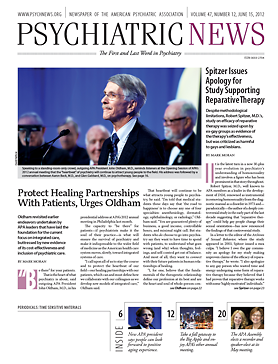“Be there” for your patients.
That is the heart of what psychiatry is about, said outgoing APA President John Oldham, M.D., in his presidential address at APA’s 2012 annual meeting in Philadelphia last month.
The capacity to “be there” for patients—if psychiatrists make it the soul of their practice—is what will ensure the survival of psychiatry and make it indispensable to the wider field of medicine as the American health care system moves, slowly, toward integrated systems of care.
“I call upon all of us to stay the course and to protect the heartbeat of our field—our healing partnerships with our patients, which can and must define how we collaborate with our colleagues as we develop new models of integrated care,” Oldham said.
That heartbeat will continue to be what attracts young people to psychiatry, he said. “I’m told that medical students these days say that ‘the road to happiness’ is to choose any one of four specialties: anesthesiology, dermatology, ophthalmology, or radiology,” Oldham said. “You are guaranteed plenty of business, a good income, controllable hours, and minimal night call. But students who do choose to go into psychiatry say they want to have time to spend with patients, to understand what goes wrong (and why) when thoughts, feelings, and self-control get out of balance. And most of all, they want to connect with their future patients in human relationships of healing.
“I, for one, believe that the fundamentals of the therapeutic relationship define our profession at its best and are the heart and soul of whole-person-centered medicine—this is the real road to happiness,” Oldham said.
“Integrated Care” was the theme of Oldham’s presidential year and of this year’s annual meeting, and he reiterated four points that he outlined the previous year in Honolulu when he assumed the APA presidency: psychiatry is part of the house of medicine, psychiatric patients have a right to quality treatment, fragmented care is not quality care, and research and education provide the best blueprint for the future of psychiatric practice.
In his address, the outgoing president “circled back” to some landmark endeavors of past APA leaders that have formed a foundation for the current focus on integrated care. Among them:
A task force appointed in 2003 by past APA President Paul Appelbaum, M.D., and chaired by past APA President Steven Sharfstein to develop “A Vision for the Mental Health System”
A follow-up report to the APA Board of Trustees in 2004
A 2008 position statement titled “Principles for Health Care Reform for Psychiatry,” derived and updated from the earlier Shartstein/Appelbaum reports and emphasizing that psychiatry should be integrated with medicine in primary care settings and hospitals
A 2009 position statement titled “Report on the Integration of Psychiatry and Primary Care,” which stressed that integrated care is more than mere co-location of two distinct services; it requires interdisciplinary communication, collaboration, and coordination of service delivery
“It is interesting in the spirit of circling back to revisit these aspects of our APA vision and to evaluate how we have done,” Oldham told psychiatrists in Philadelphia. “In my judgment, we have done pretty well, though better in some areas than in others. Sometimes very good ideas, such as integrated care, are ahead of their time, or they are impeded by fiscal and political circumstances.”
But today, eight years after the original report to the Board, Oldham cited evidence of the cost-effectiveness of this kind of collaborative care, including a 2010 study in the New England Journal of Medicine by Wayne Katon, M.D., and colleagues on patients with co-occurring depression and diabetes or heart disease (Psychiatric News, May 18). “The collaborative intervention group outperformed the controls on all measures at 12 months, including cholesterol levels, systolic blood pressure, depression scores, quality of life, and satisfaction with care,” Oldham stated.
Now, Oldham said, the wider field of medicine has come to regard treatment of mental illness as crucial to a truly integrated system of care. He cited the document “The Patient-Centered Medical Home” being developed jointly by the American Academy of Family Physicians, the American Academy of Pediatrics, the American College of Physicians, and the American Osteopathic Association, which reads as follows:
“Science has rendered untenable the implausible and artificial division of people into parts, particularly mental and physical parts. Given that over half of primary care patients have a mental or behavioral diagnosis or symptoms that are significantly disabling, given that every medical problem has a psychosocial dimension, given that most personal care plans require substantial health behavior change—a patient-centered medical home would be incomplete without behavioral health care expertise and treatment support fully incorporated into its fabric. A whole-person orientation simply cannot be imagined without including the behavioral together with the physical.”
Oldham said, “As we wrestle with changes in health care, battle to sustain parity for our patients, fight to improve reimbursement rates, educate about the effectiveness of psychiatric treatment, … work tirelessly to combat stigma, and pursue all of the values so carefully articulated a decade ago in APA’s Vision for the Mental Health System, and as we embrace integrated care in partnership with the rest of medicine, we need to remember… to
be there for our patients. Actually, it takes more than remembering—we need to
insist on the essential healing nature of the therapeutic relationship.”


